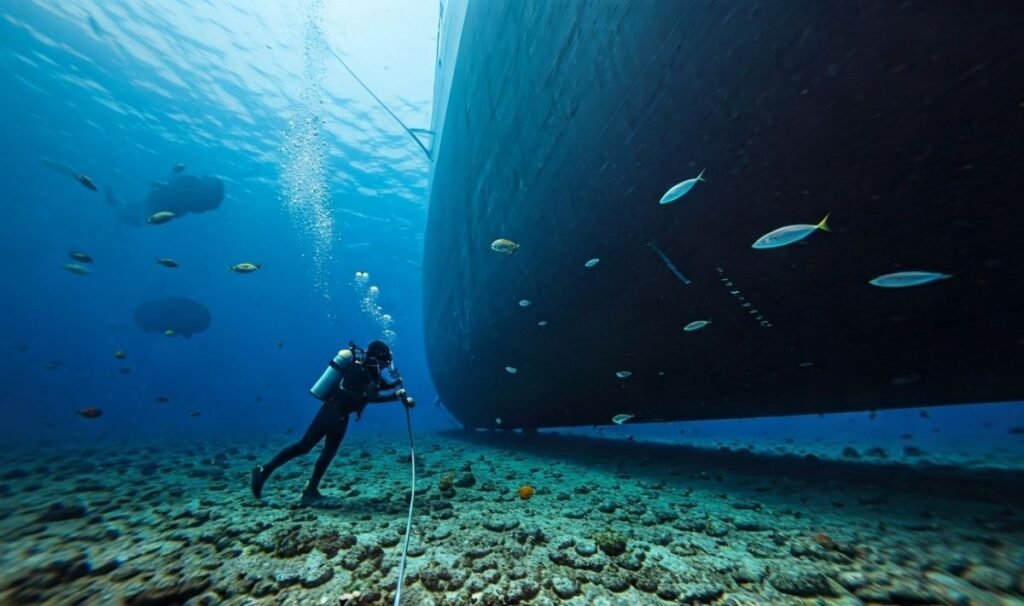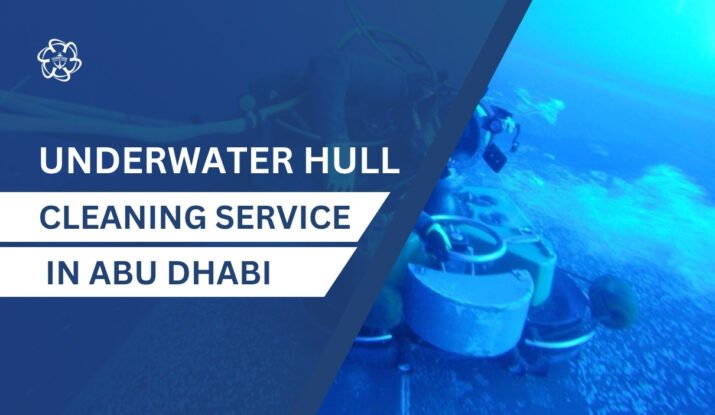Underwater hull cleaning in Abu Dhabi is a vital part of keeping ships efficient, safe, and environmentally responsible. With Abu Dhabi’s ports serving as major gateways for global trade, maintaining vessel performance below the waterline is just as important as what happens above it. Let’s explore how underwater hull cleaning in Abu Dhabi is managed in this world-class maritime hub.
Understanding Underwater Hull Cleaning in Abu Dhabi
Underwater hull cleaning involves removing marine growth—such as algae, barnacles, and biofilms—from the submerged surfaces of a ship’s hull. This is performed while the vessel remains afloat, using skilled divers and specialized equipment, ensuring minimal disruption to port operations
Marine organisms attach to hulls over time, increasing drag and reducing efficiency. This leads to higher fuel consumption, increased emissions, and potential delays. Regular cleaning keeps the hull smooth, helping ships move efficiently and meet regulatory standards

Overview of Abu Dhabi Ports For Underwater hull cleaning in Abu Dhabi
Abu Dhabi Ports operates a network of strategic ports and terminals across the Emirate, including Khalifa Port and Zayed Port. These facilities are critical for trade, logistics, and the region’s economic growth, handling a diverse range of cargo and vessel types
Marine Services at Abu Dhabi Ports
The ports offer comprehensive marine services, including pilotage, tug assistance, and underwater hull cleaning in Abu Dhabi. These services are designed to keep vessels in optimal condition and ensure smooth port operations.
What Causes Hull Fouling?
Warm, nutrient-rich waters in the Arabian Gulf encourage the growth of barnacles, mussels, and algae on ship hulls. This biofouling is a natural process, but can quickly become a problem if not managed
Impact on Vessel Performance
Even a thin layer of slime can increase drag by up to 10%, while heavy fouling can slow a ship and increase fuel costs by 20% or more. This is like trying to swim with a heavy coat on—inefficient and exhausting.
Benefits of Underwater Hull Cleaning
Improved Fuel Efficiency
A clean hull reduces resistance, allowing engines to work less and save fuel. This results in lower operating costs and improved voyage times.
Enhanced Speed and Maneuverability
Less drag means ships can maintain higher speeds and respond more quickly to steering, which is crucial for busy ports like Abu Dhabi.
Environmental Advantages
Regular cleaning reduces fuel consumption and emissions and helps prevent the spread of invasive species by removing them before ships travel to new waters
How is Underwater Hull Cleaning in Abu Dhabi
Professional Diving Teams
Certified commercial divers, equipped with advanced gear, perform underwater hull cleaning in Abu Dhabi. These professionals follow strict safety protocols and use the latest technology to ensure thorough cleaning without damaging hull coatings
Tools and Techniques Used
Divers use hydraulic brushes, high-pressure water jets, and sometimes remotely operated vehicles (ROVs). The choice of tool depends on the type of fouling and the hull’s protective coating. Some companies use advanced machines like the “Triton V” with adjustable brushes for safe, efficient cleaning.
Safety Protocols for Divers
Safety is paramount. Divers must follow real-time communication, backup support, and emergency procedures. Only certified professionals are allowed to perform these tasks in Abu Dhabi’s ports
Environmental Compliance at Abu Dhabi Ports
Underwater hull cleaning is strictly regulated. It is only permitted if essential for vessel safety or efficiency and requires prior consent from the Harbour Master. Waste from cleaning must be collected and disposed of by licensed contractors, and methods must prevent the release of harmful substances or organisms into the water
Challenges in Underwater Hull Cleaning in Abu Dhabi
The Arabian Gulf’s high temperatures, strong currents, and occasional poor visibility can make underwater cleaning challenging. Careful planning and scheduling are essential. Some marine organisms are particularly stubborn, requiring specialized equipment or multiple cleaning sessions. The use of vacuum recovery systems is encouraged to capture debris and prevent pollution.
Additionally, strict environmental regulations demand eco-friendly practices, placing pressure on service providers to balance efficiency with compliance. Coordinating with busy port schedules, ensuring diver safety, and minimizing vessel downtime further complicate operations. These challenges require experienced teams, modern tools, and precise execution to deliver effective and responsible hull cleaning.
Choosing the Right Service Provider in Abu Dhabi
Look for companies with certified divers, modern equipment, and a strong safety and environmental record. Experience with local regulations and port conditions is a major advantage, like Cleanship.co
Several reputable firms operate, offering underwater hull cleaning in Abu Dhabi and related services.
Conclusion
Underwater hull cleaning in Abu Dhabi plays a vital role in maintaining vessel performance, safety, and environmental compliance. Marine growth, like barnacles and algae, can increase drag, reduce speed, and raise fuel consumption. Abu Dhabi’s ports, equipped with advanced technology and strict maritime regulations, ensure that hull cleaning is performed efficiently and responsibly.
Skilled divers and eco-friendly methods are used to protect both the vessel and the marine environment. In a region central to global trade, regular underwater hull maintenance is not just a best practice—it’s a necessity that keeps ships running smoothly and sustainably, right from below the waterline.
FAQ:
Q1: Is underwater hull cleaning allowed in Abu Dhabi ports?
Yes, but only if essential for vessel safety or efficiency, and with prior approval from the Harbour Master. Strict environmental controls apply.
Q2: How often should hull cleaning be done in Abu Dhabi?
Frequency depends on vessel type, operating conditions, and antifouling coatings, but regular cleaning (every 3-6 months) is common for active vessels.


